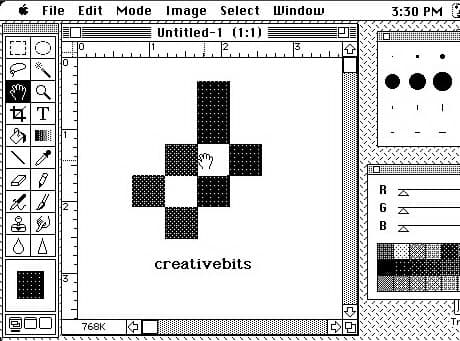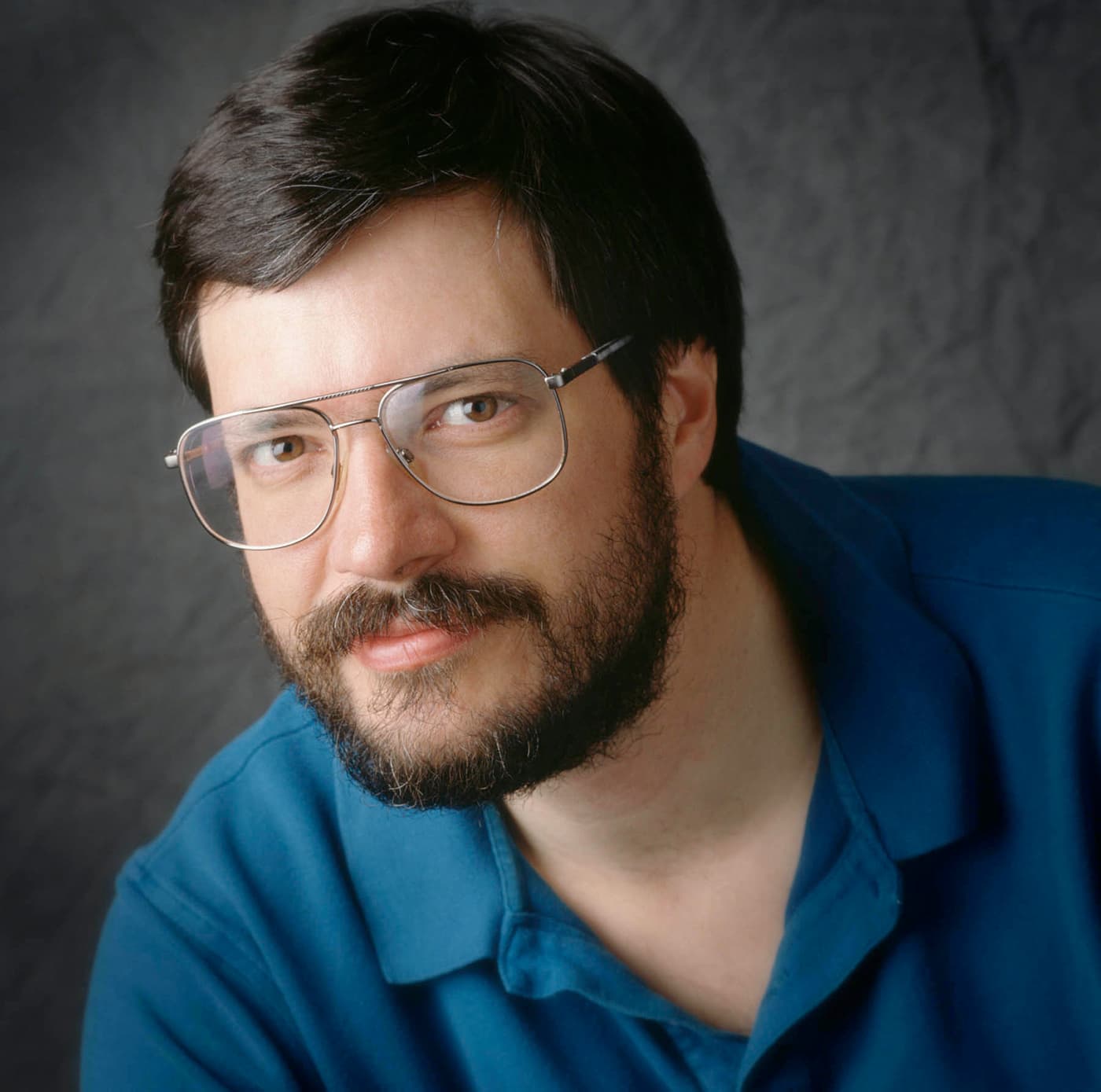In the mid-eighties I had one of my photographs retouched on a Quantel Graphics Paintbox at Robert Maxwell’s BPCC video graphics company. Apparently, Maxwell acquired it so The Mirror newspaper could retouch the ‘spot the ball’ competition photographs. But BPCC’s operators Steve Seal, Mark Bullen and Richard Baker showed it could to do much more than that and throughout the eighties and beyond produced groundbreaking work in stills and video. Even by today’s standards what you could do then was still really impressive, but completely out of reach for the average photographer.
The emergence of Photoshop

Early Photoshop interface:
This shows a very early Photoshop interface before Photoshop was coded so that it could work with colour images.
Screen capture courtesy of Creativebits.org.
Photoshop was the brainchild of two brothers: Thomas and John Knoll. Back in the autumn of 1987, Thomas Knoll started to develop programming code on his Mac Plus computer that would allow him to display greyscale images on a black and white bitmap monitor. He did this in his spare time from his home in Ann Arbor, mainly as a diversion from working on his doctoral thesis on computer vision at the University of Michigan. He called the code “Display”.
Meanwhile, his brother, John was working at George Lucas’s movie visual effects company, Industrial Light and Magic and experimenting with computers to create special effects. John needed help programming a computer to process digital files and Display seemed to be a good-enough starting point.
The two brothers arranged the purchase of a new, colour-enabled Macintosh II computer, for which Thomas rewrote the code for Display so it could work with 24-bit RGB colour images. They then worked together to expand what Display could do, adding the ability to read different file formats, while John developed the very first filter plug-ins (which are still in the program today). To quote Thomas, “We developed it originally for our own personal use… it was a lot a fun to do.”
By the summer of 1988, John figured they might be able to turn Display into a commercial product. Thomas was concerned by the amount of work this would take, but John was convinced it would be worth it and that they could somehow make money out of it.
While John toured Silicon Valley looking for a buyer, Thomas took a six-month break from his studies so he could work on the code. They were having problems working out what to call the program though and it was around this time that during a private demo someone suggested they use the name ‘Photoshop’.
Eventually, John struck a deal with a scanner company called Barneyscan for Photoshop to be supplied with their scanners. So, the first commercially available version of Photoshop was actually shipped as Barneyscan XP (version 0.87). Meanwhile, John kept approaching other companies to see who else might be interested.

First ever image that was processed in Photoshop:
Jennifer in Paradise was a photo shot by John Knoll of his girlfriend (now wife), Jennifer while on holiday in Fuji. This photograph was used in the early testing of the Display program, so can be said to be the first ever image to be processed in Photoshop. It was also used in early Adobe Photoshop demonstrations.
© John Knoll
Demonstrating to Adobe
The Knoll brothers weren’t the only ones to be working on digital imaging software that could be run on a home computer. There was a program called PhotoMac. Aldus were working on something in-house and Letraset were developing a program called ColorStudio.
The Knoll brothers got the chance to do a demonstration at Adobe, where the primary art director, Russell Brown was convinced that Photoshop was better than anything else he had seen. Soon after, in September 1988, the brothers shook hands on a deal with Fred Mitchell, head of Adobe Acquisitions to buy a licence to distribute Photoshop.
The legal paperwork was completed by April 1989 and between then and Photoshop 1.0 shipping in February 1990, Thomas worked to refine the code, while John and Russell cajoled him into adding more features. Adobe Photoshop 1.0 was Mac only, but it did well and made quite an impact. And a lot of this was due to Russell Brown’s lively demos, which helped make Photoshop look cool and fun to work with.
Early development of Photoshop
The Photoshop 1.0 engineering team was essentially just Thomas working on his own.

Photoshop 1.0 floppy disk:
The first version of Photoshop was deliberately constrained to 745KB so that it could fit on a single, 800KB floppy disk.
Photo: © Jeff Schewe
For version 2.0, Adobe hired Mark Hamburg, who was instrumental in adding paths to Photoshop.
Photoshop 2.0 also featured CMYK support, followed by Photoshop 2.5, which added Windows and 16-bit support. At this point sales of the program really started to take off, which led to an interesting situation, because as I mentioned earlier, up until this point Adobe only had a licence to distribute Photoshop and the Knoll brothers earned a royalty on each version sold. So Adobe wanted to negotiate a buyout.
One account I heard is that Thomas got an urgent call from his brother John to fly immediately to Mountain View, California to discuss a deal and Thomas returned home a few days later with a nice big cheque for the first installment payment. As for how much the brothers got paid nobody knows, though Thomas was able to indulge in his passions for aviation and photography. He also chose to continue working for Adobe on a contract basis and still works today on Camera Raw.
Over the years more features were added to the program. Photoshop 3 notably included layers, Photoshop 4 saw the addition of adjustment layers, while Photoshop 5 included the History feature and shook things up by adding an ICC-based colour management system. It took a while for the ICC profile colour-managed workflow to become accepted and it wasn’t till version 6 that Photoshop’s colour management got refined to the system we now use today. As colour guru Bruce Fraser liked to say about Photoshop 5 colour management “it’s push button simple, as long as you know which of the 50 odd buttons to press and in which order”.
Photoshop and photography
Despite its name, it was initially designers and illustrators who were using Photoshop the most. It wasn’t until around version 5 that photographers were identified as key purchasers. This was at a time when computer hardware had become powerful enough for more photographers to work with Photoshop on high-resolution images and also coincided with improvements to digital camera technology.
More and more photographers became fans of Photoshop, helping it to become the de facto program for digital image editing. In 2002 Thomas Knoll acquired a Canon EOS 10D camera and while taking photographs on holiday in Italy, he became interested in engineering his own raw processing program. The outcome of this was the Camera Raw 1 plug-in, which initially shipped as a paid upgrade for Photoshop 7.01. Later versions were included with the Photoshop CS and CC programs, as well as being incorporated into Lightroom’s Develop module.
Surprisingly, few of the Photoshop team were themselves actually using Photoshop to edit their own photographs, or at least not seriously. However, in 2003, Adobe gave each member of the team a Canon Digital Rebel/300D camera as a Christmas bonus. As a result of this there grew a better understanding and communication between the team who were producing Photoshop and the photographer users.
The engineers were much better able to identify photographic problems, work out optimum solutions and understand the problems photographers were talking about. Many of the Photoshop team can now be considered fine photographers in their own right. Thomas Knoll himself has had a longstanding interest in photography, which he inherited from his father Glen, while others, such as Russell Brown, Eric Chan, Kelly Castro (on the Lightroom team) and Julieanne Kost are all producing interesting work.
The low points
Adobe Stock Photos
There have been a few key points where the relationship between Adobe and photographers soured. In 2003, Adobe released Photoshop CS, which featured Adobe Stock Photos. This allowed customers to sell and buy royalty free images via the Bridge program interface. Adobe were warned against doing this in advisory group meetings, but went ahead anyway. Not surprisingly, it caused huge uproar among professional photographers, angered at Adobe’s endorsement of royalty-free.
To be fair, the royalty-free market resulted from photographers themselves supporting this business model long before Adobe Stock Photos. It wasn’t till 2008 that Adobe Stock Photos was eventually dropped, but the damage had been done. Adobe and Photoshop were now perceived as a big business and not much different than Apple or Microsoft.
Creative Cloud
More recently, there was disquiet at the way Photoshop and other programs in the creative suite were all moved to the Creative Cloud, a subscription only service. For UK customers the initial plans that were offered worked out prohibitively expensive, especially if you were a photographer who was only interested in using Photoshop.
Adobe responded by introducing the Photographer’s plan, which offered a special package that included Photoshop and Lightroom. This currently costs £8.57 per month. When you consider Photoshop 1.0 retailed at just under $900 when it was first released, that’s not a bad price, especially when you take into account how much the program has grown this last quarter of a century, from a 745KB application supplied on a series of floppy discs to a 1.5GB download.
Photoshop’s influence and legacy, on Photoshop’s 25th anniversary
The Photoshop program has created a whole host of other industries, from books to DVDs to specialist websites and third-party plug-ins. For example, just look at the size of the National Association of Photoshop Professionals and events such as Photoshop World.
The word ‘Photoshop’ is often used as a verb, something the Adobe legal department are keen to prevent in order to protect their trademark (to maintain validity and protect the trademark from becoming generic).
This is why you often see the term “airbrushing” being used to describe image manipulation, which sounds terribly archaic, like something you do while listening to the wireless, or playing a gramophone record. This in turn has led to wider public debates about the appropriateness of computer retouching, especially regards the heavy use of Photoshop on model and celebrity photographs. The worst excesses are delightfully chronicled on Photoshopdisasters.com. These days nearly every photograph you see in a magazine, book or poster will at some point have been processed in some way using Photoshop.
Among amateur photographers and image-makers the choice of software is more diverse, but Photoshop has become ubiquitous throughout the publishing industries for image processing and design work.
What is next for Photoshop?
People often ask, what can Photoshop possibly offer next. Seetha Narayanan, who has worked as an engineer on the program from the early years recalled how even people within Adobe thought that after Photoshop 3.0 there wasn’t much more that could be added to Photoshop. Yet 21 years later a large team of engineers continue to add new features.
The focus now is much broader and includes video and 3D, but at heart its greatest legacy will be the way it helped revolutionise digital imaging, and made high-end retouching affordable and accessible for millions of photographers.
When I think back to my first experience watching Robert Maxwell’s Quantel Paintbox in action, I for one, could ever have imagined any of this would have been possible, or how a single program could have such a huge impact on the photography industry.
© Martin Evening
I would like to thank Jeff Schewe for his help researching this article and for supplying the stills and portrait photographs of the Knoll brothers. Further detailed information about Photoshop’s early history can be found at: schewephoto.com/pei/index.html










